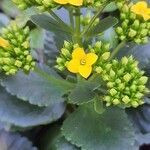Sparse, succulent shrublet, 1-several erect, terete stems, up to ± 1.5 m high. Leaves petiolate, ovate to oblong, clasping, 40-110 x 30-90 mm, glabrous to hairy, obtuse, cuneate to cordate, crenate, ± folded lengthwise, yellowish green. Inflorescence a rounded thyrse with many dichasia ending in monochasia. Corolla yellow or orange; tube elongate-ampullaceous, 10-12 mm long; lobes orange. Flowering time Aug.-Oct.
A shrub that keeps growing from year to year. It has one or two erect stems 1.5 m tall. The leaves are oval and 4-11 cm long by 3-9 cm wide. They have blunt teeth.

